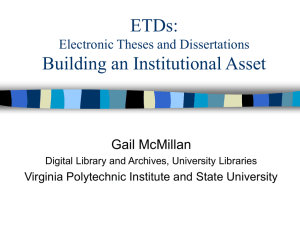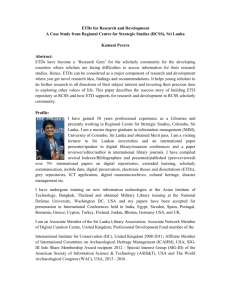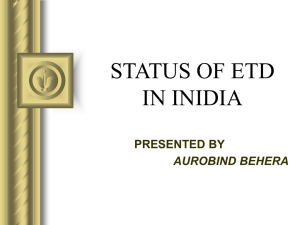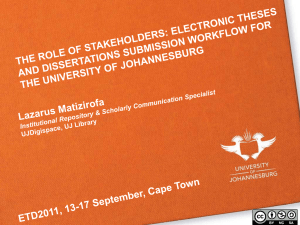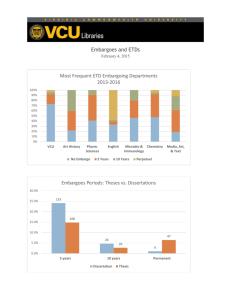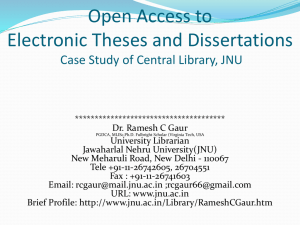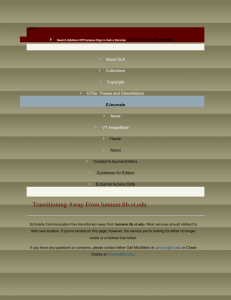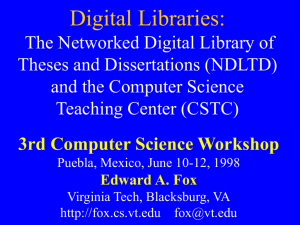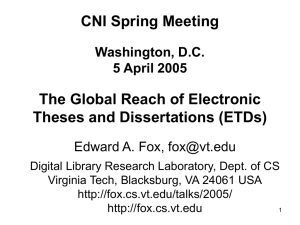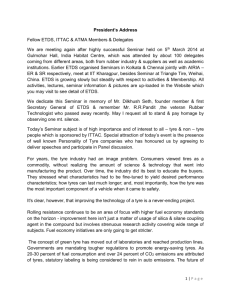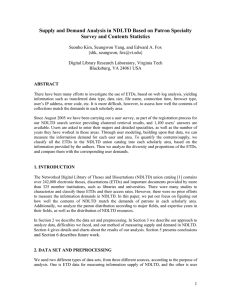Electronic Theses and Dissertations
advertisement
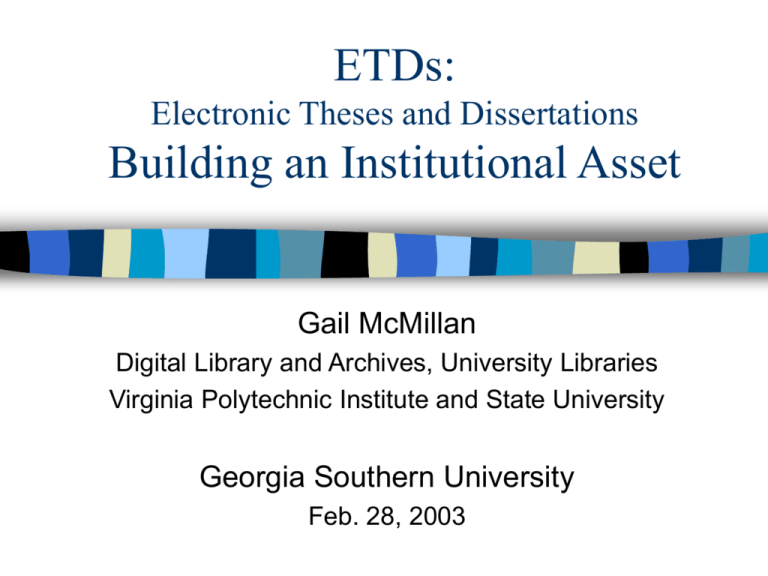
ETDs: Electronic Theses and Dissertations Building an Institutional Asset Gail McMillan Digital Library and Archives, University Libraries Virginia Polytechnic Institute and State University Georgia Southern University Feb. 28, 2003 The Current Situation Basic and substantial applied research in U.S. takes place in universities – 400,000 annual masters and PhD candidates Small portion of valuable data and material published Theses and dissertations relatively inaccessible and underutilized Scanned paper documents are costly to store and less effective than born digital documents The Vision for ETDs Improve graduate education – Training for technology skills and information literacy – Apply that knowledge to research, build, submit ETDs – Students learn about e-publishing and using digital libraries Faster and better information transfer – Empower students to convey richer message through use of multimedia – Universities publish their scholarship – Research is more easily and widely available Save students money – Use software in campus computer labs or purchase – Printing and special paper requirements eliminated Library Goals for ETDs Improve library services – Better turn-around time – Availability • 24 x 7 • More widely shared among scholars regardless of ability to pay – Information more easily found • Word-indexed and searchable (Boolean, phrases too) • More extensive cataloging • Links everywhere Save money – Fewer staff required for greater access • Catalog from etext (programmatically or copy/paste) • Eliminate handling (shelving, circulating, binding, etc.) Save space – VT saves ~166 linear feet of shelf space annually Status of ETDs at Virginia Tech Partnership of the Library, Graduate School, Faculty Approved through university governance (Mar.1996) for full implementation Jan.1997 Web submission – Students: http://etd.vt.edu – Programmers: http://scholar.lib.vt.edu/ETD-db/ Workshops for students (and faculty) Over 4,588 ETDs approved ETDs Worldwide: NDLTD Networked Digital Library of Theses and Dissertations www.ndltd.org 144 universities, 21 associations – No charge to join, share the wealth of information – 66 US institutions have projects • 40 Council of Graduate Schools, 20 Land Grant; 24 ARL – Required at (41): Cal Tech, Concordia, Drexel, Duquesne,ETSU, LSU, NCSU, UF, UGa, [UKentucky, UMaine], UNT, USF, UT Austin, UVA, VT, WVU, WPI, Yale, and 22 international institutions >10,000 born digital ETDs Q uickTim e™ and a Cinepak decom pr essor ar e needed t o see t his pict ur e. http://scholar.lib.vt.edu/theses/available/etd-2227102539751141/ http://scholar.lib.vt.edu/theses/available/etd-32498-21232/ http://scholar.lib.vt.edu/theses/available/etd-4220121649751351/ ETDs at Virginia Tech Graduate student creates ETD – Student’s committee approves Student submits online – – E-mail notification programmatically sent to authors, advisors, UMI Library stores and provides access – – – Completes web form Authors/advisors prescribe Internet access Graduate School approves – Word processor, standard multimedia software Server, search engine Appropriate levels of access to ETDs Catalogs What isn’t happening? Library Resources--not just ETDs Hardware: server – Maintenance and security – Started small – Upgrades as needed Software – Submission and management scripts written by VT’s DLA – Log files analyzed with Analog – Surveys Search engine – Started small – Grew: InfoSeek’s ULTRASEEK • Index every word (including from PDF files) • Search: keywords, Boolean, and phrases • Browse any tagged field Benefits: High use, low margin Include ETDs with other digital library activities – EJournals, EReserve, digital images, etc. – Additional resources may not be necessary • On-hand staff, equipment, software, shareware • At VT: start-up costs = $0 – Estimate $65,000 from zero base for ETD project • $24,000 Staff (part time) • $36,000 Equipment • $15,000 Software Available for adaptation: VT software for ETD submission, availability management, notification Growing Popularity of VT ETDs 5,000,000 4,500,000 4,000,000 3,500,000 3,000,000 2,500,000 2,000,000 1,500,000 1,000,000 500,000 ETD files requested Abstracts requested 1997/98 231,709 165,710 1997/98 483,030 215,493 User surveys – 67% found VT ETDs easily – 61% found them by searching – 22% browsed by department – 16% browsed by author – 53% downloaded 1 or more ETDs 1999/00 578,152 260,699 2000/01 2,173,420 573,149 2001/02 4,497,199 471,917 Availability of 4,588 VT ETDs Worldwide Access 58.5% VT-only Access 24.6% Mixed Access 2.6% Inaccessible 14.3% VT Authors’ Reasons for Restricting Access Othe r Personal choice Advice of faculty Advice of publisher 20 01/0 2 July/Dec. 20 02 Patent pending Advice of others 0.0% 10 .0% 20 .0% 30 .0% 40 .0% 50 .0% Surveys of Publishers – No specific policies for ETDs – Consider submissions individually – Chapter greatly rewritten for different audience, peer review Surveys of VT ETD Alumni – None had problems getting published Early controversies waning 60 .0% Challenges to ETD Initiatives Making information literacy an expectation of education Informing students and faculty about copyright responsibilities Informing students and faculty of their rights as holders of copyright their original works Changing the attitudes of publishers about ETDs Establishing a preservation system for e-documents that is as acceptable as paper or microfilm ETDs and Copyright Author’s rights – Retain rights – Share non-exclusive rights • Permit library to store and to provide access • Publishers Author’s obligation: balance all 4 fair use factors or get permission Notification: optional, recommended Registration: optional Factors Effecting Archiving: Align Commitment and Resources Access – 24x7 online from stable server – Standard multimedia formats • Not necessarily paper-based • PDF: open source software – URNs • Preserve links to ETDs • Broken links within ETDs Security Graduate student authors give formal permission to store and provide access Cooperative Archiving Commercial Options – Frequent back-ups – Distributed copies Format migration – Library with university computing expertise and outside collaborators Lessons from ETDs Easy and inexpensive to implement and maintain – Online access, security, archiving works Implementation of new formats – – – – Innovative ETDs fewer than expected Text and book oriented Not planning for online readers Standard multimedia formats If you have them, they will get used. – Access far exceeded expectations: remarkable increase in exposure to research – Disappointing number are inaccessible – Increasing number and diversity of NDLTD institutions ETD Information Resources Information about VT’s ETD initiative http://scholar.lib.vt.edu/theses Customizable automated submission/management software http://scholar.lib.vt.edu/ETD-db/ Student guidelines, training materials, FAQ's, multimedia educational materials http://etd.vt.edu NDLTD: Networked educational institutions – Annual conferences: Berlin 2003, U of Kentucky 2004, Uof New South Wales 2005 (?) http://www.ndltd.org
